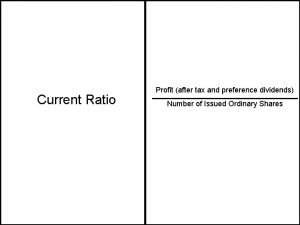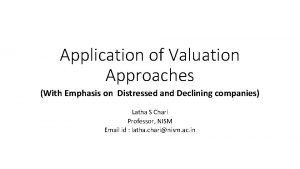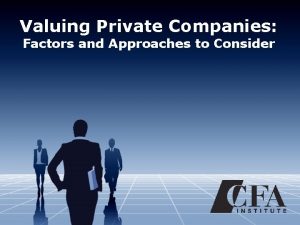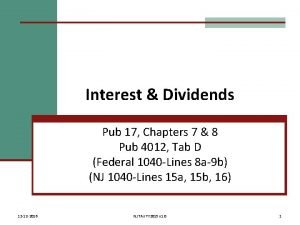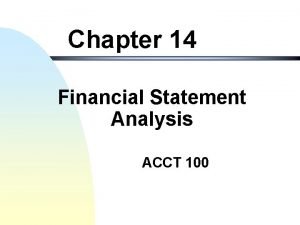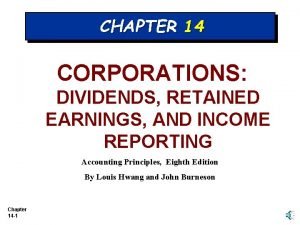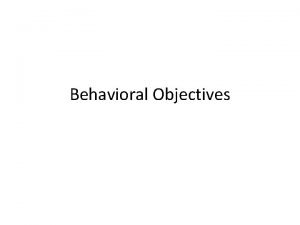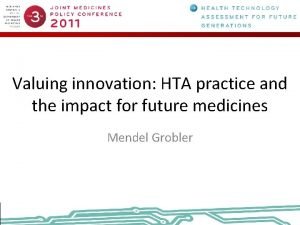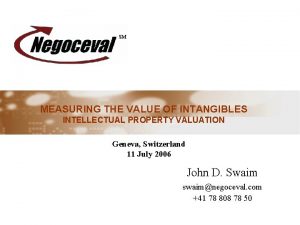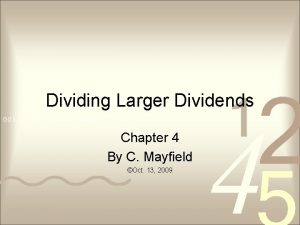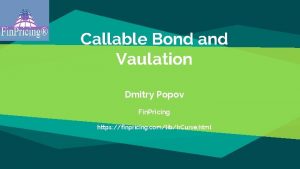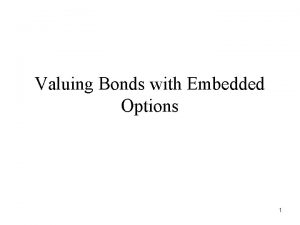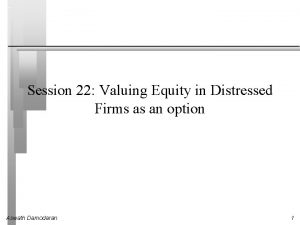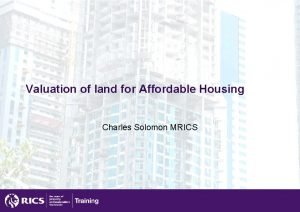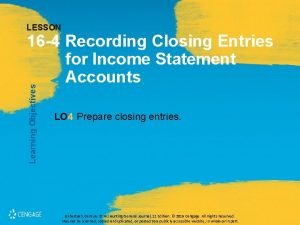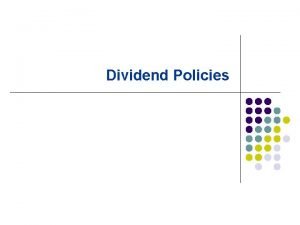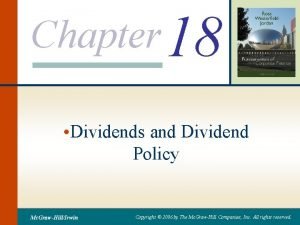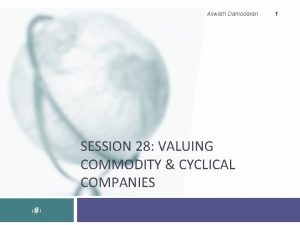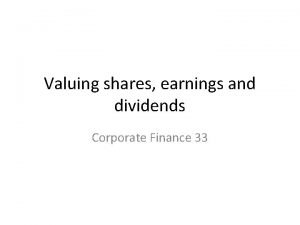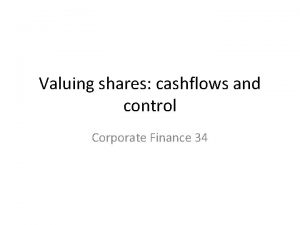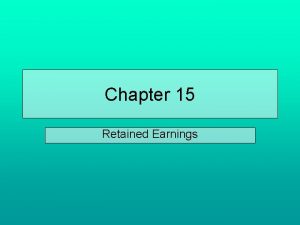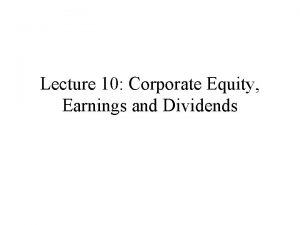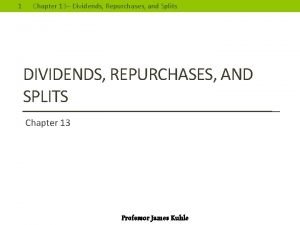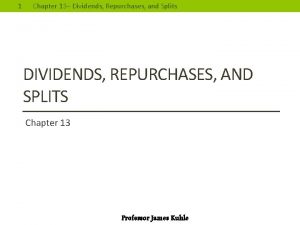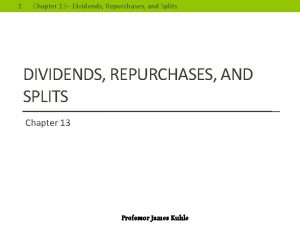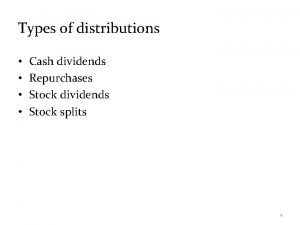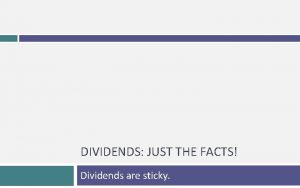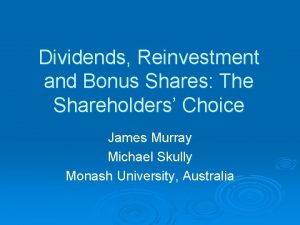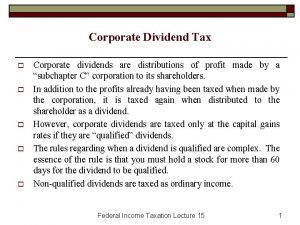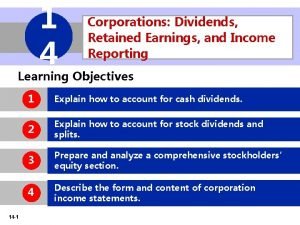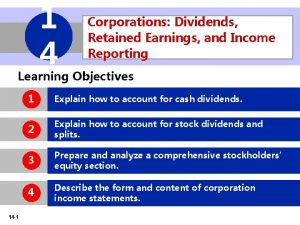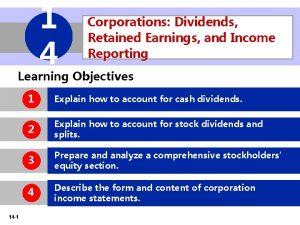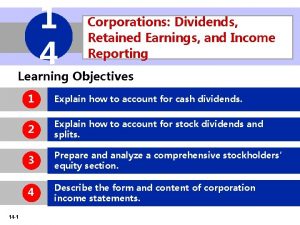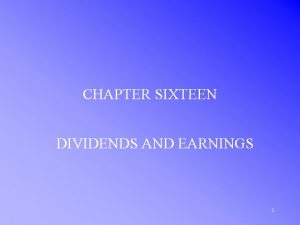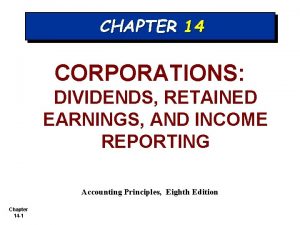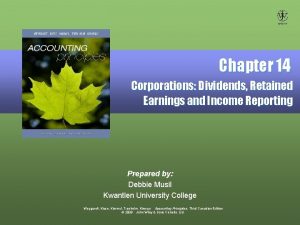Valuing shares earnings and dividends Corporate Finance 33


























- Slides: 26

Valuing shares, earnings and dividends Corporate Finance 33

Valuing shares: assets, dividends and earnings • The principal determinants of share prices • Estimate share value using a variety of approaches • The most important input factors • Net asset valuation • Dividend valuation models • Price earning ratio models

Share valuation: the challenge • Two skills are needed to be able to value shares: 1 Analytical ability, to be able to understand use mathematical valuation models 2 Good judgement is needed • Assets such as cars and houses are difficult enough to degree of accuracy value with any • Corporate bonds generally have a regular cash flow an anticipated capital repayment (coupon) and • With shares there is no guaranteed annual payment and capital repayment no promise of

Valuation using net asset value (NAV) Source: Pearson plc, Annual Review 2006.

Net asset values and total capitalisation of some firms Source: Annual reports and accounts; www. advfn. com 7. 5. 07.

What creates value for shareholders?

When asset values are particularly useful • Firms in financial difficulty • Takeover bids • When discounted income flow techniques are difficult to – 1 Property investment companies – 2 Investment trusts – 3 Resource-based companies apply

The dividend valuation models • The market value of ordinary shares represents the sum of the expected future dividend flows, to infinity, discounted to present value • The only cash flows that investors ever receive from a company are dividends. • An individual holder of shares will expect two types of return: – (a) income from dividends – (b) a capital gain d 1 P 0 = –––––– + –––––– 1 + k. E

Worked example • At the end of one year a dividend of 22 p will be paid and expected to be sold for £ 2. 43 • The rate of return required on a financial security of this 20 per cent. d 1 P 0 = –––––– + –––––– 1 + k. E 22 243 P 0 = –––––– + –––––– = 221 p 1 + 0. 2 the shares are risk class is


Worked example • If a firm is expected to pay dividends of 20 p per year to infinity and the rate of return required on a share of this risk class is 12 per cent then: 20 20 P 0 = –––––– + –––––––– + … + ––––––– 1 + 0. 12 (1 + 0. 12)3 (1 + 0. 12)n P 0 = 17. 86 + 15. 94 + 14. 24 +. . . + Given this is a perpetuity there is a simpler approach: d 1 20 P 0 = –––––– = 166. 67 p k. E 0. 12

The dividend growth model • If the last dividend paid was d 0 and the next is due in one year, d 1, then this will amount to d 0 (1 + g). Shhh plc has just paid a dividend of 10 p and the growth rate is 7 per cent then: d 1 will equal d 0 (1 + g) = 10 (1 + 0. 07) = 10. 7 p d 2 will be d 0 (1 + g)2 = 10 (1 + 0. 07)2 = 11. 45 p d 0 (1 + g)2 d 0 (1 + g)3 d 0 (1 + g)n P 0 = ––––––-- + –––––––– + … + –––– (1 + k. E)2 (1 + k. E)3 (1 + k. E)n 10 (1 + 0. 07)2 10 (1 + 0. 07)3 10 (1 + 0. 07)n P 0 = –––––––––– + … + ––––– 1 + 0. 11 (1 + 0. 11)2 (1 + 0. 11)3 (1 + 0. 11)n d 1 d 0 (1 + g) 10. 7 P 0 = –––––– + –––– = ––––– = 267. 50 p k. E – g 0. 11 – 0. 07

Pearson plc Ö 10 29. 3 ––––– – 1 = 0. 062 or 6. 2% 16. 1 If it is assumed that this historic growth rate will continue into the future (a big if) and 10 per cent is taken as the required rate of return d 1 29. 3 (1 + 0. 062) P 0 = ––––––––––––– = 819 p k. E – g 0. 10 – 0. 062 g=

Non-constant growth • Noruce plc has just paid an annual dividend of 15 p per share and the next is due in one year • For the next three years dividends are expected to grow at 12 per cent per year • After the third year the dividend will grow at only 7 per cent per annum • Expected return of 16 per cent per annum Stage 1 Calculate dividends for the super-normal growth phase. d 1 = 15 (1 + 0. 12) = 16. 8 d 2 = 15 (1 + 0. 12)2 = 18. 8 d 3 = 15 (1 + 0. 12)3 = 21. 1

Noruce Stage 2 Calculate share price at time 3 when the dividend growth rate shifts to the new permanent rate. d 4 d 3 (1+g) 21. 1 (1 + 0. 07) P 3 = –––––– + –––– = ––––––– = 250. 9 k. E – g 0. 16 – 0. 07 Stage 3 Discount and sum the amounts calculated in Stages 1 and 2. d 1 16. 8 –––– = ––––– 1 + k. E 1 + 0. 16 d 2 18. 8 + –––– = ––––– (1 + k. E)2 (1 + 0. 16)2 d 3 21. 1 + –––– = ––––– (1 + k. E)3 (1 + 0. 16)3 P 3 250. 9 + –––– = ––––– (1 + k. E)3 (1 + 0. 16)3 = 14. 5 = 14. 0 = 13. 5 = 160. 7 202. 7 p

Issues with DGM • What is a normal growth rate? • Companies that do not pay dividends • Problems with dividend valuation models – 1 They are highly sensitive to the assumptions d (1 + g) 24. 2 (1 + 0. 08) 0 e. g. Pearson: P 0 = ––––––––––––– = 1, 742 p k. E – g 0. 095 – 0. 08 – 2 The quality of input data is often poor – 3 If g exceeds k. E a nonsensical result occurs

Forecasting dividend growth rates – g • Determinants of growth – 1 The quantity of resources retained and reinvested within the business – 2 The rate of return earned on those retained resources – 3 Rate of return earned on existing assets

Growth • Focus on the firm – 1 Strategic analysis – 2 Evaluation of management – 3 Using the historical growth rate of dividends – 4 Financial statement evaluation and ratio analysis • Accounts have three drawbacks: (a) they are based in the past (b) the fundamental value-creating processes within the firm are not identified and measured in conventional accounts, (c) they are frequently based on guesses, estimates and judgements • Focus on the economy

The price-earnings ratio (PER) model Current market price of share 200 p Historic PER = –––––––––––––– = 20 Last year’s earnings per share 10 p Source: Financial Times, 5 May 2007. Reprinted with permission.

PERs for the UK and US (S&P 500) stock markets, 1964– 2007

The crude and the sophisticated use of the PER model • Some analysts use the historic PER (P 0/E 0), to make between firms comparisons • Analysing through comparisons lacks intellectual rigour – The assumption that the ‘comparable’ companies are correctly priced is a bold one • It fails to provide a framework for the analyst to test the implicit input assumptions d 0 P 0 = ––––––– k. E – g P 0 d 1/E 1 = ––––––– E 1 k. E – g important

Ridge plc • Payout ratio of 48 per cent of earnings • Discount rate 14 per cent • Expected growth rate 6 per cent d 1/E 1 P 0 = ––––––– E 1 k. E – g P 0 0. 48 = –––––– = 6 E 1 0. 14 – 0. 06 • Now assume a k. E of 12 per cent and g of 8 per cent P 0 0. 48 = –––––– = 12 E 1 0. 12 – 0. 08 • If k. E becomes 16 per cent and g 4 per cent then the PER reduces to two-thirds of its former value: P 0 0. 48 = –––––– = 4 E 1 0. 16 – 0. 04

Whizz plc • Earnings per share rise by 10 per cent per annum • Prospective price earnings ratio (PER) of 25 • Beta of 1. 8, Risk premium 5 per cent, Current risk-free rate of return is 7 per cent k. E = rf + β (rm – rf) k. E = 7 + 1. 8 (5) = 16% P 0 d 1 / E 1 0. 5 = ––––––––––––– = 8. 33 E 1 k. E – g 0. 16 – 0. 10

Prospective PERs for various risk classes and dividend growth rates

A comparison of the crude PER and the more complete model

Lecture review • Valuation using NAV • The dividend valuation models • Growth rate • Price-earnings ratio model
 Objectives of corporate finance
Objectives of corporate finance Net profit after tax and preference dividends
Net profit after tax and preference dividends Valuing distressed and declining companies
Valuing distressed and declining companies Valuation of private companies
Valuation of private companies Specified private activity bond interest dividends
Specified private activity bond interest dividends Affective domain responding
Affective domain responding Dividends of workplace diversity
Dividends of workplace diversity Record date for dividend
Record date for dividend Acct 100
Acct 100 Declaration of stock dividend journal entry
Declaration of stock dividend journal entry Affective behavior at the level of valuing
Affective behavior at the level of valuing Affective behavior at the level of valuing
Affective behavior at the level of valuing Pericles describes athenian society as valuing
Pericles describes athenian society as valuing Valuing oral language quotes
Valuing oral language quotes Valuing innovation
Valuing innovation Intellectual property valuing
Intellectual property valuing Aspects of honesty
Aspects of honesty Dmsbr
Dmsbr Callable bond definition
Callable bond definition Effective duration formula
Effective duration formula Valuing distressed companies
Valuing distressed companies Valuing culture
Valuing culture Valuing land for social housing
Valuing land for social housing Closing entries dividends
Closing entries dividends Homemade dividend example
Homemade dividend example The information content of dividends refers to
The information content of dividends refers to Valuing commodity companies
Valuing commodity companies

